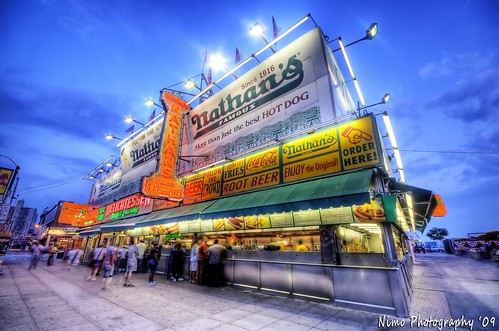
Nathan's Famous Franks, We're Still HERE BROOKLYN!!!!!!!!!!!, originally uploaded by The Talented Mr. Nimo.
I cant lie, this is one of my favorite places to eat. I try to stay away as much as possible. Very expensive and no good for your health.But once in a while wont hurt. Much of Coney Island is gone, but Nathan's still remains and as you can see business isnt so bad either. Since 1916 and counting.
Coney Island is a peninsula, formerly an island, in southernmost Brooklyn, New York City, USA, with a beach on the Atlantic Ocean. Theneighborhood of the same name is a community of 60,000 people in the western part of the peninsula, with Seagate to its west; Brighton Beachand Manhattan Beach to its east; and Gravesend to the north.
The area was a major resort and site of amusement parks that reached its peak in the early 20th century. It declined in popularity after World War II and endured years of neglect. In recent years, the area has seen the opening of KeySpan Park, home to the Brooklyn Cyclones minor league baseball team.
Coney Island is the westernmost of the barrier islands of Long Island, about four miles (6 km) long and one-half mile wide. It used to be an island, separated from the main part of Brooklyn by Coney Island Creek, part of which was little more than tidal flats. There were plans into the 20th century to dredge and straighten the creek as a ship canal, but they were abandoned and the center of the creek was filled in for construction of the Belt Parkway before World War II. The western and eastern ends are now peninsulas.
Coney Island became a resort after the Civil War as excursion railroads and the Coney Island & Brooklyn Railroad streetcar line reached the area in the 1860s. With the rail lines, steamship lines and access to the beach came major hotels and public and private beaches, followed byhorse racing, amusement parks, and less reputable entertainments such as Three-card Monte, other gambling entrepreneurs, andprostitution.
When the Brooklyn Rapid Transit Company electrified the steam railroads and connected Brooklyn to Manhattan via the Brooklyn Bridge at the beginning of the 20th century, Coney Island turned rapidly from a resort to an accessible location for day-trippers seeking to escape the summer heat in New York City's tenements.
Charles I. D. Looff, a Danish woodcarver, built the first carousel at Coney Island in 1876. It was installed at Vandeveer's bath-house complex at West 6th Street and Surf Avenue. The complex was later called Balmer's Pavilion. The carousel consisted of hand-carved horses and animals standing two abreast. Two musicians, a drummer and a flute player, provided the music. A metal ring-arm hung on a pole outside the ride, feeding small, iron rings for eager riders to grab. A tent-top protected the riders from the weather. The fare was five cents.
From to 1885 to 1896, the Coney Island Elephant was the first sight to greet immigrants arriving in New York, who would see it before they saw the Statue of Liberty.
Nathan's Famous original hot dog stand opened on Coney Island in 1916 and quickly became a landmark. An annual hot dog eating contest has been held there on July 4 since its opening, but has only attracted broad attention and international television coverage during the last decade.
In 1915 the Sea Beach Line was upgraded to a subway line, followed by the other former excursion roads, and the opening of the New West End Terminal in 1919 ushered in Coney Island's busiest era.
After World War II, contraction began seriously from a series of pressures. Air conditioning in movie theaters and then in homes, along with the advent of automobiles, which provided access to the less crowded and more appealing Long Island state parks, especially Jones Beach, lessened the attractions of Coney's beaches. Luna Park closed in 1946 after a series of fires and the street gang problems of the 1950s spilled over into Coney Island. The presence of threatening youths did not impact the beachgoing so much as it discouraged visitors to the rides and concessions - the staples of the Coney Island economy. A major blow was struck in 1964 when Steeplechase Park, the last of the major parks, closed.
The effective director of public works in New York City, Robert Moses, actively opposed the "tawdry" entertainment at Coney and discouraged the building of new amusements. Housing projects, for low and moderate incomes, were built in what had been amusement areas, and the aquarium project, where Dreamland once stood, reduced the available area for more traditional amusements.
In Coney Island's lowest years there was some incremental improvement in relatively small areas, notably the preservation and later the expansion of what had been the rides area at the back of the Feltman's property as Astroland. The general improvement in New York City's infrastructure, commercial prospects and image after the 1970s fiscal crisis under the mayoral administration of Edward I. Koch helped Coney Island, and many improvements were made under the mayoralty of Rudolph Giuliani, continuing with his successor, Mayor Michael Bloomberg, helped by the Wall Street booms of the 1980s and 1990s, which brought considerable money to the City through financial industry taxes.
"A journey of a thousand miles must begin with a single step." -- Lao Tzu
Copyright © Demetrios the Traveler

No comments:
Post a Comment